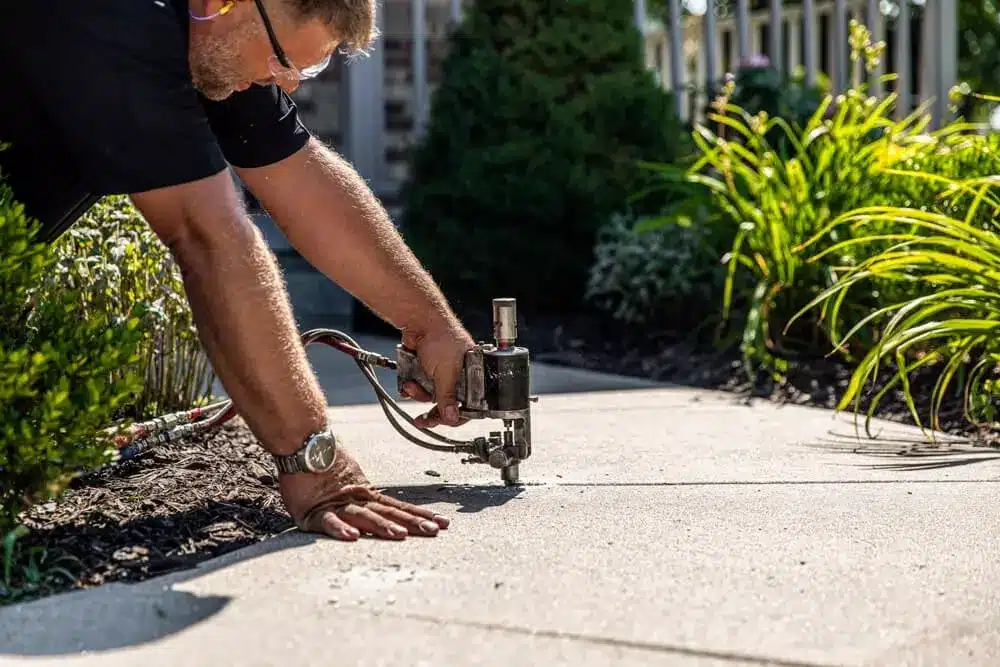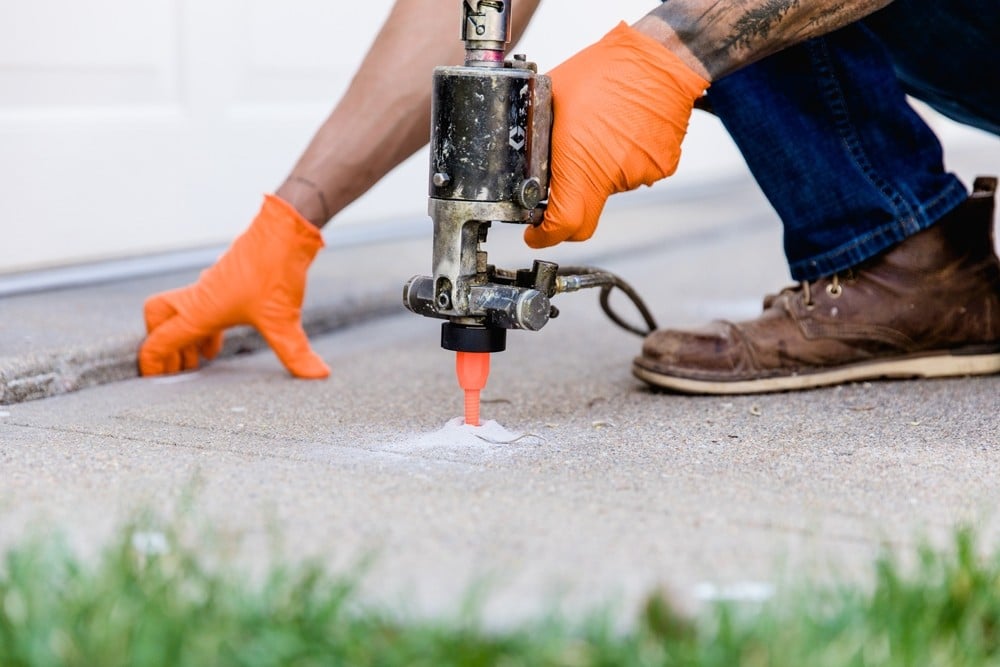Cracked vs. Broken: What’s the Real Difference?
Surface Cracks
These are hairline or small-to-medium cracks caused by:
- Shrinking during the curing process
- Minor soil movement
- Freeze-thaw cycles in Chicagoland winters
Good news: Surface cracks don’t typically compromise the structural integrity of your concrete and can often be sealed and leveled successfully.
Structural Damage
Deep, wide cracks that go all the way through the slab, especially if paired with displacement or crumbling edges, may indicate:
- Soil washout or erosion beneath the slab
- Severe differential settlement
- Poor subgrade preparation
In some cases, severely broken concrete may need to be replaced—but not always.

Causes of Uneven Concrete
Uneven concrete is a common issue that can affect any concrete floor or slab, and it often starts with problems beneath the surface. One of the leading causes is soil erosion, where water washes away the ground supporting the concrete slab, creating voids and gaps underneath. When the soil beneath a slab shifts or settles unevenly, the concrete above can crack, tilt, or sink, resulting in an uneven concrete surface.
Poor compaction of the ground before pouring the concrete is another frequent culprit. If the soil isn’t packed down firmly, it can settle over time, causing the slab to move and develop cracks. Even natural settling of the soil can lead to similar problems, especially in areas with fluctuating moisture levels or unstable ground.
These issues not only create tripping hazards and unsightly cracks but can also compromise the stability of your concrete floor. To help prevent uneven concrete, it’s important to ensure the ground is stable and well-compacted before installation. Regularly filling cracks and gaps as soon as they appear can also help maintain a level surface and prevent further erosion or shifting.
When Can Cracked Concrete Be Leveled Instead of Replaced?
If the slab is still largely intact and the cracking is accompanied by sinking or tilting, that’s a strong indication that polyurethane concrete leveling is a great solution.
The condition of the existing concrete matters when deciding whether to level or replace a slab, as some issues can be effectively addressed without full replacement.
When leveling is possible, polyurethane injection is often the best way to address sunken slabs, as it lifts and stabilizes the existing concrete for long-term results.
Leveling is usually possible when:
- The slab is unbroken but uneven
- There are visible gaps or voids underneath
- The cracks are cosmetic or minor
- You’re seeing tripping hazards or pooling water
Replacement is likely needed when:
- The slab is shattered into multiple pieces
- The concrete is soft, crumbling, or flaking (spalling)
- You want to change the design, layout, or finish
Safety Precautions for Concrete Leveling
When tackling a concrete leveling project, safety should always come first. Whether you’re using self-leveling concrete or another repair method, it’s essential to protect yourself and ensure the job site is safe. Start by wearing the right protective gear: gloves to shield your hands, safety glasses to protect your eyes from dust and debris, and a dust mask to avoid inhaling fine particles.
Make sure the area where you’re working is well-ventilated, especially if you’re using chemicals or self-leveling compounds. Check that all your equipment, such as ladders or scaffolding, is in good condition before you begin. Before applying any repair or leveling material, thoroughly clean the concrete floor to remove all debris—this is an important step for both safety and a successful repair.
Always follow the manufacturer’s instructions for any self-leveling concrete or repair products you use, and take care to avoid skin or eye contact with these materials. By taking these precautions, you’ll help ensure your concrete leveling project is both safe and effective.
How Polyurethane Foam Lifting Works
Our PolyLevel® concrete lifting system uses high-density polyurethane foam, which is quickly installed, to fill voids under the slab and gently lift it back into place. The foam is mixed before injection, ensuring the right mix for effective lifting. Its thick, buildable consistency makes it ideal for filling large voids, and once injected, the foam expands to lift the slab. The voids are completely filled, and after lifting, the slab comes to rest on a stable base. The foam maintains its shape even in moist conditions and is water resistant, making it suitable for areas prone to moisture.
Here’s how it works:
- Small Holes Drilled: ⅝” holes are made in strategic low points on the slab.
- Foam Injection: Expanding polyurethane is injected beneath the concrete. It fills voids and lifts the slab with precise control.
- Quick Cure: The foam hardens in minutes—ready for foot traffic in 30-45 minutes and vehicles in 2-4 hours.
- Sealing: The small holes are patched, and the surface is cleaned.
This method is minimally invasive, long-lasting, and more affordable than full replacement.

Benefits of Concrete Leveling with Perma-Seal
- Fast Results: Most projects are generally completed quickly and efficiently, often in a day.
- Cost-Effective: Often 30–50% less than replacement.
- Minimal Mess: No demolition, no hauling heavy debris.
- Long-Lasting: Closed-cell foam resists water and erosion.
- Chicago-Tough: Designed to withstand freeze-thaw cycles.
- Flooring Ready: A level surface is ideal for installing vinyl or tile flooring.
- Improved Usability: Leveling improves the safety and usability of any space, such as basements, living areas, or home offices.
- Home Value: A level concrete floor is important for the safety and value of your house.
Common Mistakes to Avoid When Leveling Concrete
Leveling a concrete floor can be a straightforward DIY project, but there are a few common mistakes that can undermine your results. One of the biggest pitfalls is failing to properly prepare the surface before applying self leveling concrete or any repair material. If the floor isn’t clean, dry, and free of debris, the new concrete or leveling compound may not bond well, leading to a weak or uneven surface.
Another frequent mistake is choosing the wrong repair material for the job. For example, using a patching compound on a large, uneven area instead of a self leveling solution can result in a surface that isn’t truly flat or durable. It’s also important to allow the repair material to fully cure before walking on or installing flooring over the area—rushing this step can cause cracks or unevenness to reappear.
To achieve a long lasting, smooth, and level surface, always follow the manufacturer’s instructions, select the right material for your specific repair, and give the new concrete or leveling compound plenty of time to cure. Taking these steps will help ensure your concrete leveling job is a success.
Chicago Homeowners: Don’t Replace Until You Know Your Options
Cracked or uneven concrete doesn’t always mean the end of the road. Fixing and patching cracked or uneven concrete is possible with modern methods, such as concrete lifting, patch compounds, or other repair techniques, before considering full replacement. With our proven concrete lifting technology, Perma-Seal can restore your sidewalks, steps, pool decks, and driveways with little disruption to your daily life.
Schedule your free inspection with Perma-Seal today. Call 800-421-7325 or click the button below to fill out our online contact form.







